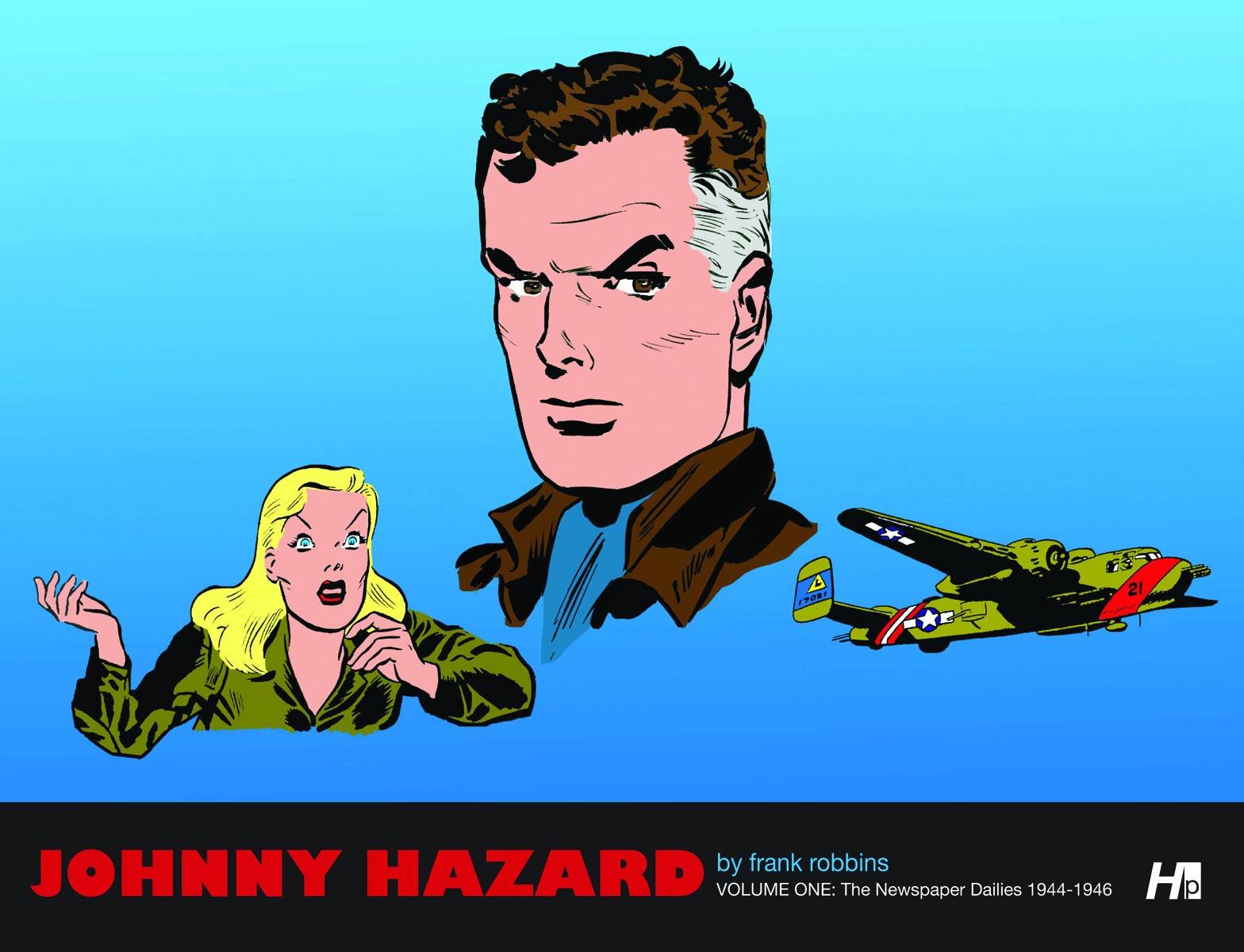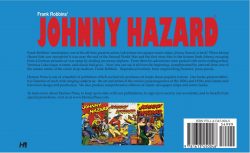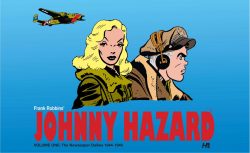


By Frank Robbins with an introduction by Daniel Herman (Hermes Press)
ISBN: 978-1-61345-004-8 (HB/Digital edition)
Johnny Hazard was a newspaper strip created in the style and manner of Terry and the Pirates, but in many ways this steely-eyed hero most resembles – and indeed predates – Milton Caniff’s second masterwork Steve Canyon. Unbelievably, until 2011 this stunningly impressive, enthralling adventure strip had never been comprehensively collected in archival volumes – at least not in English – although selected highlights had appeared in magazines like Pioneer Comics, Dragon Lady Press Presents and the Pacific Comic Club.
Boston born, Franklin Robbins (9th September 1917 – 28th November 1994) was an artistic prodigy who shone from early on. At age nine he was awarded a scholarship to the Boston Museum of Fine Arts and at 15, moved to New York City to attend the National Academy of Design on a Rockefeller grant. Skilled, inventive and prolific as both painter and graphic artist, he freelanced continually, even working with Edward Trumbull on the legendary murals for the NBC building and Radio City Music Hall.
Robbins created graphics for RKO Pictures, worked in advertising and magazine illustrations but never stopped painting, with work shown at the Whitney Museum of American Art, Metropolitan Museum of Art, The Corcoran Gallery of Art and Walker Art Gallery, although he found his perfect medium of expression when invited to take over a top comic strip…
Even whilst relentlessly creating a full seven days of newspaper strips, he exhibited work at the Whitney Museum of American Art’s Annual show and – after ending his comics career – retired to Mexico to end his days with a brush in his hand.
The truth is that comics changed Robbins’ life. He was a brilliant natural cartoonist whose unique artistic and lettering styles lent themselves equally to adventure, comedy and super-heroic tales, whilst his expansive raconteur’s gifts made him one of the best writers over three generations.
He first found popular fame in 1939 by taking over aviation strip Scorchy Smith from Bert (The Sandman) Christman, who had left America to fight with the Flying Tigers in China. Robbins thrived in the role and created a Sunday page for the feature in 1940.
The groundbreaking feature had been originated by John Terry before the astounding Noel Sickles replaced him: revolutionising it and – with Milton Caniff – inventing a new impressionistic style of narrative art to reshape the way comics were drawn and perceived .
Robbins remained until 1944 and was then offered high-profile Secret Agent X-9. Instead, he devised his own lantern-jawed, steely-eyed man of action.
A tireless and prolific worker, even whilst producing the daily and Sunday Hazard (with a separate storyline for each), Robbins continued freelancing as an illustrator for The Saturday Evening Post, Look, Life and a host of other mainstream magazines. He also tried comic books for the first time when Johnny Hazard won his own title in 1948-1949, just as superheroes began being supplanted by he-men, gangsters and monsters…
Robbins tried again in 1968: quickly becoming a key contributor as both artist and writer on Superboy, The Flash and The Atom, as well as a regular contributor to humour mag Plop! and DC’s mystery and war anthologies. He particularly excelled on Batman, Batgirl and Detective Comics where, with Neal Adams, he created Man-Bat, before following Michael Kaluta as artist on The Shadow.
Moving to Marvel in the 1970s, Robbins concentrated on drawing a variety of titles including Captain America, Daredevil, Ghost Rider, Morbius, The Man from Atlantis, Human Fly, Power Man and The Invaders – which he co-created with Roy Thomas.
When Johnny Hazard launched on Monday June 5th 1944, he was an aviator in the US Army Air Corps. When hostilities ceased, he briefly became a freelance charter pilot and spy before settling into the of a globe-girdling, troubleshooting mystery-solver: a modern day Knight Errant. The strip ended in 1977: one more victim of diminishing panel-sizes and the move towards simplified, thrill-free, family-friendly gag-a-day graphic fodder to frame small-ads. In its time it was syndicated in nine different languages in thousands of newspapers across the world, and even scored a residency in 1950s British weekly Rocket.
This fabulous hardcover/digital series – reproduced from original King Features proofs – at long last re-presents the definitive magnum opus in fitting form: a monochrome, landscape format archival collection of the first 2 years (covering June 5th 1944 to November 11th 1945), resurrecting the Amazing Aviator in followers’ hearts and hopefully finding new fans.
The action begins with a selection of those 1948 comic book covers and an informative ‘Introduction: Frank Robbins and Johnny Hazard’ by Daniel Herman before we meet the man himself in ‘The Escape’.
Here, the reader meets coolly capable flyer Lt. Johnny Hazard and his pals Loopy and Scotty as – having escaped from a German POW camp – they break into a Nazi air field to steal a bomber and fly home. Fast-paced, sharp-tongued and utterly gung-ho, the yarn introduces a cunning, charming, happy-go-lucky lout, insouciantly ruthless and prepared at every stage to risk his own freedom and life if it means killing a few more of the enemy and sabotaging the German war effort.
His saga truly begins with the 5th July episode as the liberated and again ready-for-duty airman touches base with friendly civilians only to meet feisty, headstrong and dedicated war photographer ‘Brandy’ during an air raid. All sorts of sparks fly as a series of spectacular events continually push them together and ultimately passionate fury and disgust on both sides turns to something else amidst all the deadly missions and flaming firepower.
The romantic turning point comes when Brandy impetuously parachutes into occupied territory to get a perfect shot and Hazard – hating himself every moment – goes after her…
The strip could not keep up with the fast-moving events after D-Day (the real world Allies invaded “Fortress Europa” the day after Johnny Hazard debuted) and third story arc ‘Sun Tan and General Mariwana’ – opening on September 11th 1944 – saw the hero’s squadron transferred to the Pacific Theatre of Operations to reinforce the battle against Japan. Through ingenious means Brandy inveigles herself into the picture as recently promoted Captain Hazard and his crew undertake a top-secret mission couriering a Chinese resistance leader back to her people.
Enigmatic Sun Tan is both staggeringly beautiful and lethally dangerous… and the Japanese Secret Service’s top target. Her leaked intentions spark a byzantine assassination plot wherein an experimental tracking device is hidden in Brandy’s camera gear during a refuelling stopover in Iran…
The architect of the plot is Colonel Mariwana: a pilot disfigured in a previous clash with the freedom fighter. His maniacally relentless pursuit costs him his command but does succeed in bringing down Hazard’s plane in the Himalayas. Ultimately, the grim episode of revenge leads to mass-murder and desecration of temples before honour is avenged. The mission is completed, but at a punishing cost…
A new year reinforced the darker tone as January 31st 1945 opened the saga of ‘Colonel Kiri’, as Hazard sets up shop on an embattled army air base under constant assault by Japanese forces on the front line of occupied China. It also introduces ace wingman Captain “The Admiral” Slocum: last in an unbroken line of valiant patriotic mariners, but reduced to defending his country in the skies since his debilitating sea sickness prevents him from serving afloat like a true warrior…
The Americans are hard-pressed, targeted by a secret Japanese installation decimating the region. When Brandy is shot down while helping to evacuate Chinese refugees, she is sheltered by farmers who disguise her as one of them. She meets malign war criminal Kiri when he claims her as a “comfort woman” and triggers his fate by freeing recently captured Hazard and Slocum, who spectacularly sabotage the ghost base. In the chaos, carnage and confusion, the Americans steal a Japanese tank and head for their own lines…
The closing chapter here is a deft and delicious tribute to the characters of Damon Runyon, embodied in displaced, pool-addicted, New York gunsel ‘Side-Pocket Sam’ (August 13th to November 11th 1945).
As our heroes enjoy the destructive capabilities of their new ride they almost accidentally capture a major prize. High command officer General Ishigaki and his glamorous French “assistant” Mademoiselle Touché aren’t quick or smart enough to escape the fleeing Yanks, and none of them are able to avoid the army of Chinese bandits who scoop them up and deliver them to their slick Yankee boss.
Side-Pocket Sam is debonair, charming but utterly amoral. He knows one of his “guests” carries Japan’s failsafe game plan for World War III and – once it’s his – plans to make the deal of his life…
Tragically, he’s underestimated his enemies and his friends, enabling Johnny, Brandy and the Admiral to save the day and head for safety…
Sharp, snappy and devilishly funny repartee in the style of movies like Howard Hawks’ His Girl Friday and Frank Capra’s It Happened One Night is a hallmark of these rapid fire yarns, some of the greatest comic strips in history, and that in itself can present a few problems for modern readers.
Contemporary attitudes to sexuality, gender and particularly race are far from what we find acceptable – or should even tolerate – today. That situation is further compounded by an understandably fervent patriotic tone: equal parts pure jingoism and government-sponsored morale boosting.
Every contemporary-based feature of the era participated in the war effort by shaping its content accordingly, and terms like “Jap”, “Nip”, “Kraut” and many different forms of “othering” were common parlance in both movies and comics – the two main forms of popular entertainment. These slurs became a character-defining shorthand, used without consideration and thus an indelible facet of national speech and behaviour for decades to follow.
We know better now – at least most of us do – but must accept and understand that hurtful and unjust as such terms are, they did exist and we’re doing history and our society a huge and dangerous disservice by ignoring, downplaying or worst of all self-censoring those terms and the attitudes that fed them.
In truth, Johnny Hazard was far less egregious than most: Robbins may have made Kiri and Mariwana contemptible villains, but the Japanese army (who had committed many verified real world atrocities) were given fair play and did not unnecessarily suffer from the worst propagandist nonsense used by the Allies to bolster a united war spirit.
Other ethnicities – like Chinese, Iranian, Tibetans and Italians – are treated with the full dignity of different but equal cultures and depicted as competent comrades in arms, not ignorant primitives in need of a white man’s saving graces. However, arch comedian Robbins clearly couldn’t resist playing mischievous games with accents, names and speech patterns that would do Benny Hill, Hogan’s Heroes or Charlie Chan (the opposite of) proud, so if you don’t think you’re capable of remaining historically detached, best to forgo those delights that have transcended time…
To be continued…
These exotic action-romances perfectly capture the mood and magic of a distant but incredibly familiar time; with cool heroes, hot dames and exceedingly intemperate bad-guys encountering exotic locales and stunning scenarios, all peppered with blistering tension, slyly mature humour and vivid, visceral excitement.
Johnny Hazard is a brilliant two-fisted thriller-strip too long forgotten, and this is your chance to remedy that.
© 2011 King Features Syndicate, Inc. ® Hearst Holdings Inc. All rights reserved.
